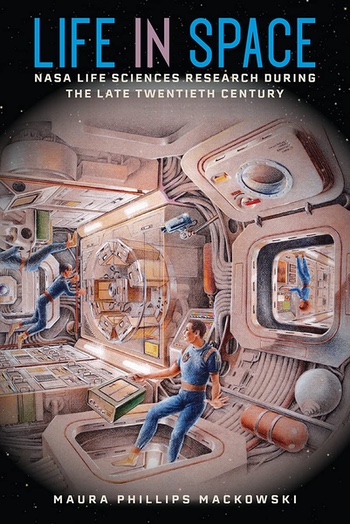Review: Life in Spaceby Jeff Foust
|
| LifeSat “had been promising in concept but unlikely to succeed in execution,” she concluded. |
With a steady stream of cargo missions like cargo Dragon, and the crewed version of that spacecraft enabling at least four NASA and other Western astronauts to be on the station at any time, research on the station is hitting its stride. “We’ve been flush with crew time and we’ve seen our ISS research sponsors respond,” Kirt Costello, chief scientist in NASA’s ISS program research office, said at the briefing. Cargo capacity and room on the station for larger research equipment, he said, was now more of a limiting factor than crew time.
It took a long time to reach that stride: decades of experience built up on the station and, before it, the Space Shuttle. In Life in Space, historian Maura Phillips Mackowski chronicles an earlier era of life science research in space and the challenges researchers faced getting funding and other support to carry out that work.
The book covers life sciences research at NASA from 1980 to 2004. Previous books covered such research at NASA early in the agency’s history, while this book was commissioned by NASA’s history office back in 2005. That era, she describes in the book’s introduction, was a “bubble” for life sciences at the agency, starting with the introduction of the shuttle and bursting with the Vision for Space Exploration, which imperiled that research by focusing the agency tightly on exploration.
The bubble, though, still has plenty of missed opportunities for life science research. The book discusses several projects that attempted to leverage the shuttle and station for that research that never got off the ground. Perhaps the most famous, or infamous, of those projects was a centrifuge for the station, going through several iterations before being left off the program despite the importance of variable, partial gravity research. Another, lesser known one is LifeSat, an effort in the late 1980s and early 1990s to develop a satellite for biosciences research, similar to the Soviet/Russian Bion, but was cut by Congress because of its projected costs. LifeSat “had been promising in concept but unlikely to succeed in execution,” she concluded.
| There was no overarching vision for life sciences research in space at NASA during that era, but instead scientists and other proponents making the best of available opportunities that often were shut down for fiscal or policy reasons. |
The book is roughly chronological in structure—the early shuttle program is discussed in the first chapter, and the Vision for Space Exploration near the end—although individual chapters focus on various themes. One chapter, for example, looks at the criticism NASA faced for a peer review system for selecting experiments that some argued did not choose the best ones. Other chapters examined the role of international cooperation, particularly the collapse of the Soviet Union and new partnerships with Russia.
As Mackowski skips among these topics, diving into deep detail (the first chapter starts with an examination of an early student-developed life science experiment developed for the shuttle), it can be a little disorienting for the reader. That may be part of the point, though: there was no overarching vision for life sciences research in space at NASA during that era, but instead scientists and other proponents making the best of available opportunities that often were shut down for fiscal or policy reasons.
That research seems on firmer ground today, thanks to the station as well as broader guidance, like decadal surveys for physical and biological sciences research in space. Current success, though, doesn’t guarantee future achievements, particularly in the longer term as NASA attempts to transition from the ISS to commercial stations. Life in Space is a reminder of the challenges that life sciences research faced at NASA and a warning of what could happen if those hard-earned lessons are not remembered.
Note: we are using a new commenting system, which may require you to create a new account.
